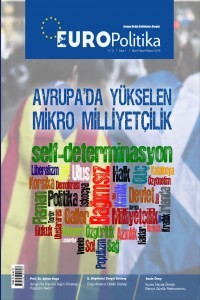THE DISCURSIVE RIFTS WITHIN EU REGARDING CHINA’S ANTI COVID-19 DIPLOMACY - THE AMBIVALENCE OF THE EU’S STRATEGIC POSITION UNDER THE PRESSURE OF US-CHINA’S GLOBAL CONFRONTATION
THE DISCURSIVE RIFTS WITHIN EU REGARDING CHINA’S ANTI COVID-19 DIPLOMACY - THE AMBIVALENCE OF THE EU’S STRATEGIC POSITION UNDER THE PRESSURE OF US-CHINA’S GLOBAL CONFRONTATION
Covid-19, China, Diplomacy, EU EU's Strategic,
___
- Balzacq, T. & Puybareau, B. (2018). The economy of secrecy: security, information control and EU-US relations. West European Politics, 41(4).
- BBC News. (2020, April 17). Coronavirus: Macron questions China’s handling of outbreak.
- Bechis, F. (2020, April 17). Polls show concerning effect of Chinese coronavirus charm offensive in Italy, FRI.
- CGTN. (2020, April 7). China continue to support Portugal in fighting covid-19: ambassador.
- DW News. (2020, April 10). Germany’s Maas: Trump coronavirus response took too long.
- DW World. (2020, June 1). Coronavirus pandemic further strains US-China relations.
- Eckhardt, J. (2015). Business Lobbying and trade governance: The case of EU-China relations, Palgrave Macmillan.
- Gabriel, J. & Schmelcher, S. (2018). Three scenarios for EU-China relations 2025, Futures, (97), pp. 26-34.
- Glaser, C.L. (2015). A US-China Grand Bargain? The Hard Choice between Military Competition and Accommodation, International Security, 39(4).
- Goldstein, L.J. (2015). Meeting China Half Way: How to Defuse the Emerging US-China Rivalry, George Town University Press.
- Gosling, T. (2020, May 21). China’s mask diplomacy won’t work in the Czech Republic, Foreign Policy -Argument.
- Green-Cowles, M. & Egan, M. (2016). The historical evolution of the transatlantic partnership, The West and the Global Power Shift, pp. 75-97.
- Hansrod, Z. (2020, May 21). US-China war of words over covid-19 escalates tensions over Taiwan, RFI News.
- Hauser, G. & Kernic, F. (2016). European Security in Transition, Routledge.
- Lampton, D.M. (2013). A New Type of Major-Power Relationship: Seeking a Durable Foundation for US-China Ties, Asia Policy, 16, pp 51-68.
- Lau, S. (2020, April 30). Sweden plans to ask EU to investigate the origin of covid-19, likely further straining relations with China’, South China Morning Post.
- Maher, R. (2016). The elusive of EU-China strategic partnership, International Affairs, 92(4).
- Mengru, W. (2020, March 26). China-Austria ties deepened through virus fight, China.org.cn.
- Moldicz, C. (2020, March). Hungary external relations briefing: Hungarian foreign policy in the coronavirus crisis, China-CEE Institute, 27(4).
- Petrova, A. (2020, March 19). Bulgaria says China ready to help in fight against coronavirus, Pixabay.com.
- Reuters World News. (2020, April 26). Germany says China sought to encourage positive covid-19 comments.
- Rough, P. (2020, March 25). How China is exploiting the coronavirus to weaken democracies, Foreign Policy-Argument.
- Smith, M. (2014). EU-China relations and the limits of economic diplomacy, Asia Europe Journal (January).
- Smith, S. (2020, May 19). WHO coronavirus assembly: US-China clash dominates the reaches finale, NBC News.
- Transatlantic Relations Initiative. (2020, May 14). Observatory on the EU: How will the covid-19 pandemic affect EU-China relations? Challenges and Perspectives.
- Uznanska, P. & Fila, M. (2020, May 22). The New US-China Battlefield over the Covid-19 Narrative: Poland, The Diplomat.
- Xinhua. (2020, June 7). China’s Mammoth Foundation donates covid-19 testing equipment to Latvia . Xinhua. (2020, May 13). China to continue helping Spain fight covid-19 epidemic.
- Yu, J. (2018). The belt and road initiative: domestic interests, bureaucratic politics and the EU-China relations, Asia Europe Journal (March).
- ISSN: 2149-1380
- Yayın Aralığı: Yılda 2 Sayı
- Başlangıç: 2016
- Yayıncı: Yusuf ERTUĞRAL
INTERDEPENDENCE AND HEGEMONY IN EUROPE DURING THE PANDEMIC PROCESS
POPÜLİZM VE SALGINLA ULUS DEVLETE GEÇİŞ, GIDA TEDARİK ZİNCİRİ İLE BİRLİĞE DÖNÜŞ
POST-COVID-19 SÜRECİNDE AB’NİN “ÇEVRE DÖNGÜSÜ”
COVID-19 SALGINI GÖLGESİNDE AB VE DIŞ POLİTİKA SARMALI
COVID-19 VE BREXIT’İN KUZEY İRLANDA BARIŞININ GELECEĞİNE (HAYIRLI CUMA ANLAŞMASINA) ETKİLERİ
YENİ NORMAL YOLUNDA AB’NİN YEŞİL GELECEĞİ
PANDEMİDE AVRUPA BİRLİĞİ ELEŞTİRİLERİ: KOMPLO TEORİSYENLİĞİNİN BİRLİK KARŞITLIĞIYLA ZORUNLU BİRLİĞİ
COVID-19 KRİZİ’NİN AVRUPA BİRLİĞİ’NE EKONOMİK ETKİSİ ÜZERİNE
